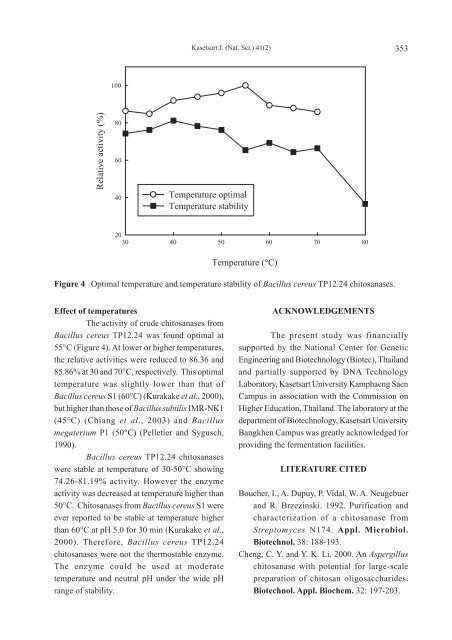April - June 2007 - Kasetsart University
April - June 2007 - Kasetsart University
April - June 2007 - Kasetsart University
You also want an ePaper? Increase the reach of your titles
YUMPU automatically turns print PDFs into web optimized ePapers that Google loves.
Relative activity (%)<br />
100<br />
80<br />
60<br />
40<br />
Effect of temperatures<br />
The activity of crude chitosanases from<br />
Bacillus cereus TP12.24 was found optimal at<br />
55°C (Figure 4). At lower or higher temperatures,<br />
the relative activities were reduced to 86.36 and<br />
85.86% at 30 and 70°C, respectively. This optimal<br />
temperature was slightly lower than that of<br />
Bacillus cereus S1 (60°C) (Kurakake et al., 2000),<br />
but higher than those of Bacillus subtilis IMR-NK1<br />
(45°C) (Chiang et al., 2003) and Bacillus<br />
megaterium P1 (50°C) (Pelletier and Sygusch,<br />
1990).<br />
Bacillus cereus TP12.24 chitosanases<br />
were stable at temperature of 30-50°C showing<br />
74.26-81.19% activity. However the enzyme<br />
activity was decreased at temperature higher than<br />
50°C. Chitosanases from Bacillus cereus S1 were<br />
ever reported to be stable at temperature higher<br />
than 60°C at pH 5.0 for 30 min (Kurakake et al.,<br />
2000). Therefore, Bacillus cereus TP12.24<br />
chitosanases were not the thermostable enzyme.<br />
The enzyme could be used at moderate<br />
temperature and neutral pH under the wide pH<br />
range of stability.<br />
<strong>Kasetsart</strong> J. (Nat. Sci.) 41(2) 353<br />
Temperature optimal<br />
Temperature stability<br />
20<br />
30 40 50 60 70 80<br />
Temperature (°C)<br />
Figure 4 Optimal temperature and temperature stability of Bacillus cereus TP12.24 chitosanases.<br />
ACKNOWLEDGEMENTS<br />
The present study was financially<br />
supported by the National Center for Genetic<br />
Engineering and Biotechnology (Biotec), Thailand<br />
and partially supported by DNA Technology<br />
Laboratory, <strong>Kasetsart</strong> <strong>University</strong> Kamphaeng Saen<br />
Campus in association with the Commission on<br />
Higher Education, Thailand. The laboratory at the<br />
department of Biotechnology, <strong>Kasetsart</strong> <strong>University</strong><br />
Bangkhen Campus was greatly acknowledged for<br />
providing the fermentation facilities.<br />
LITERATURE CITED<br />
Boucher, I., A. Dupuy, P. Vidal, W. A. Neugebuer<br />
and R. Brzezinski. 1992. Purification and<br />
characterization of a chitosanase from<br />
Streptomyces N174. Appl. Microbiol.<br />
Biotechnol. 38: 188-193.<br />
Cheng, C. Y. and Y. K. Li. 2000. An Aspergillus<br />
chitosanase with potential for large-scale<br />
preparation of chitosan oligosaccharides.<br />
Biotechnol. Appl. Biochem. 32: 197-203.
















